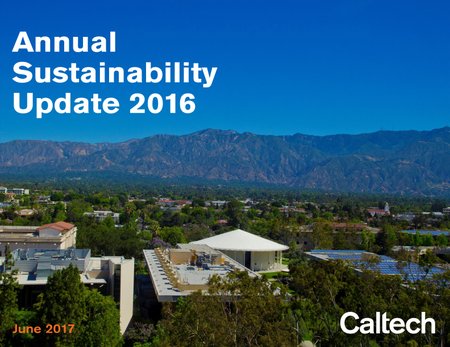Caltech sustainability efforts paid dividends in fiscal year 2016, cutting water use by 11 percent and trash generation by 5 percent while increasing hazardous material recycling by 11 percent compared to the previous year.
Those highlights, reported by Caltech Sustainability in its "Annual Sustainability Update 2016" report were among dozens of metrics showing the Institute's progress in reducing its environmental footprint. The report also highlighted areas where improvements could be made, such as increasing carpool usage and reducing greenhouse gas emissions.
John Onderdonk, director of sustainability programs, says that "progress in the last year has been steady and really strengthened long-term positive trends."
For example, he notes that the Institute has made significant progress in reducing demand for and increasing efficiency in energy and water use. Recent achievements in those areas have included: installation of a direct chilled-water loop to connect the campus's central and satellite utility plants to improve cooling in campus buildings; installing dedicated tree irrigation systems; installing low-flow urinals campus-wide; overhauling the 10-megawatt gas turbine in the central plant to bolster efficiency; and upgrading fuel cells providing 2 megawatts to boost their efficiency and reduce carbon emissions.
Here are some other highlights from the report:
- Caltech now derives 88 percent of its own power needs from on-campus sources—and those on-campus sources are 15 percent cleaner than power provided by the municipal utility;
- Water features including the Gene Pool and the Watson Lab fountain have been outfitted with systems to use recycled water from air conditioning condensation, saving as much as 200,000 gallons of water annually;
- The campus now recycles 34 percent of its waste, a 3 percent increase over the previous year;
- In 2016, the campus installed 61 Level 2 electric vehicle charging stations around campus; the stations are free to use for campus electric vehicle owners as part of a research project led by Steven Low, professor of computer science and electrical engineering, to determine how the Institute can best integrate large numbers of electric vehicles into the campus power grid. The 300-kilowatt stations can fully charge an electric vehicle in about five hours.
Onderdonk says the biggest challenge remaining is further reducing greenhouse gas emissions, which have plateaued—partly as a result of increased energy demands due to new building construction and research as well as from reliance on natural gas combustion to generate electricity and heat on campus. To address that challenge, the Institute approved an energy resource plan in April that aims to significantly decarbonize the campus's electrical supply by 2025 through the deployment of on- and off-site renewable energy projects.
The annual report—which details the goals, successes, and challenges facing the Institute in terms of sustainability—can be found at http://www.caltech.edu/content/2016-report-institute-sustainability-released.
Onderdonk says the report underscores the depth and breadth of the campus's continuing efforts to reduce its environmental impact. "Having detailed metrics and meaningful initiatives across multiple key areas—energy, water, materials, built environment, transportation, and emissions—is rare and certainly shows our commitment to transparency and sustained progress," he says.
Written by Jon Nalick




